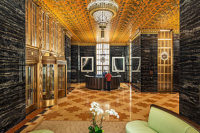In Philadelphia, the building that once housed the Philadelphia Savings Fund Society (PSFS) now functions as the Loews Philadelphia Hotel, which hosted in Republican National Convention in the summer of 2000 (page 74). Recognized as the first International style high-rise in the world, the historic PSFS building features an assortment of stone inside and out.
Originally built in 1932 as a banking tower, the building’s stonework was cleaned and repaired, and the landmark was converted into a hotel -- following the guidelines outlined by the State Historic Preservation Officer (SHPO) and the National Park Service.
The decision to convert the structure into a hotel came about when it was decided that the tower plan would no longer meet the requirements for modern flexible office space. However, planners felt that the central double-loaded corridor lent itself to a hotel guestroom layout.
The stonework on the building was restored, but crews were careful not to make the material appear newly installed. Additionally, salvaged stone was taken from areas of the building where it would no longer be used. This included the original banking counter on the second floor, which was salvaged and used as the registration counter in the new hotel on the ground floor. In all, more than 10,000 square feet of marble was salvaged during demolition for reuse in the project.
Our cover story features an even more dramatic transformation, which addressed the former Henry Hobson Richardson Allegheny County Jail in Pittsburgh, PA (page 40). This project, which converted the former jail into the new combined home of the juvenile and adult sections of the Common Pleas Court, involved a 10-year political battle with the county commissioners before sufficient funds were allotted to refurbish the 19th century structure.
Before restoration of the 200,000-square-foot facility began, the existing exterior stonework was to be cleaned and repointed. Some of the salvaged stone came from the interior, including cut stone that had been used to close up one of the arches in the past. Inside the building, the Milford Pink granites were restored, with new flooring in the same material to complement the existing stonework.
The restoration and upgrade of these historic projects -- both of which have an extremely high profile within their respective cities -- shows that even while a building may have outlived its usefulness in one incarnation, it can begin a second life in another.

